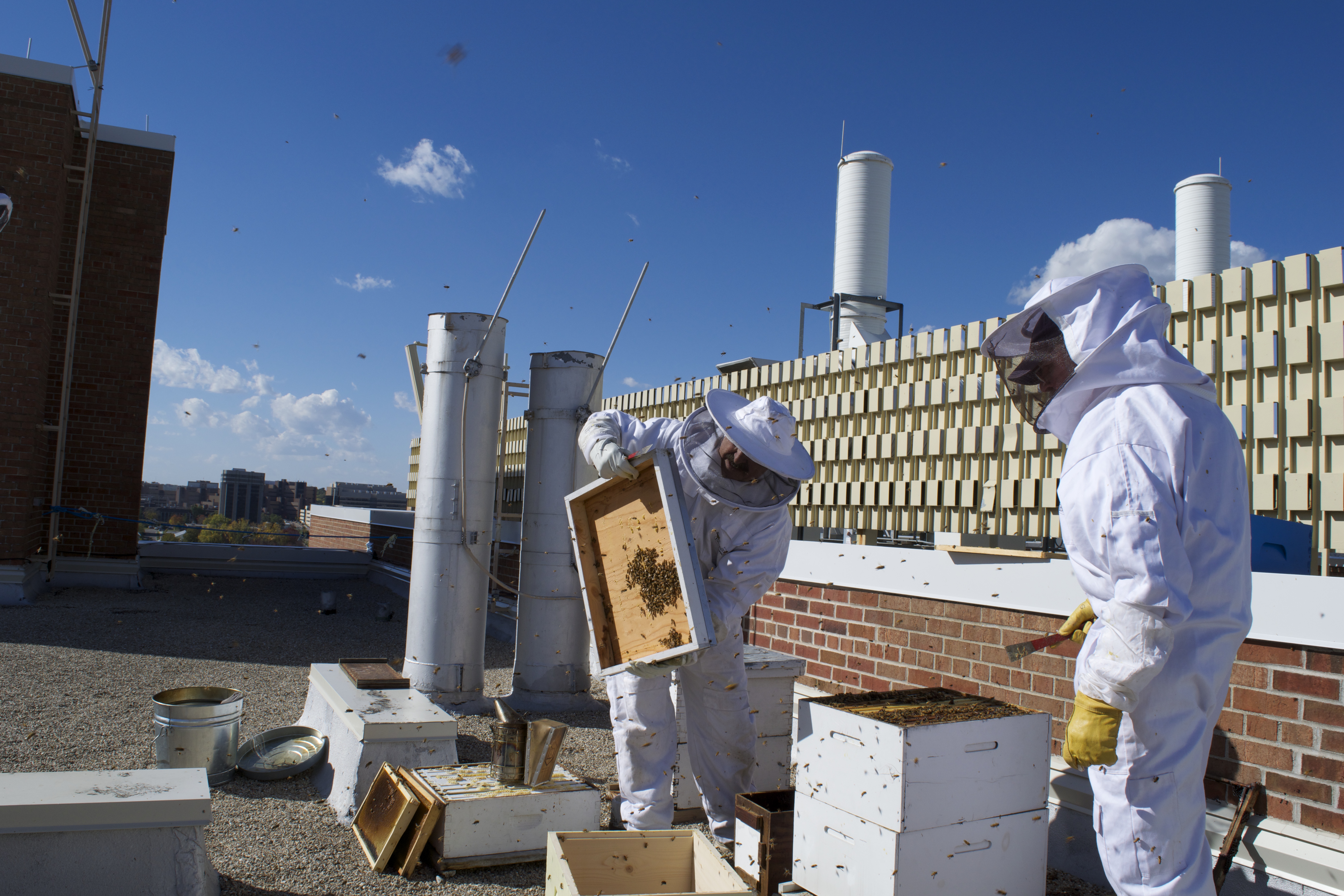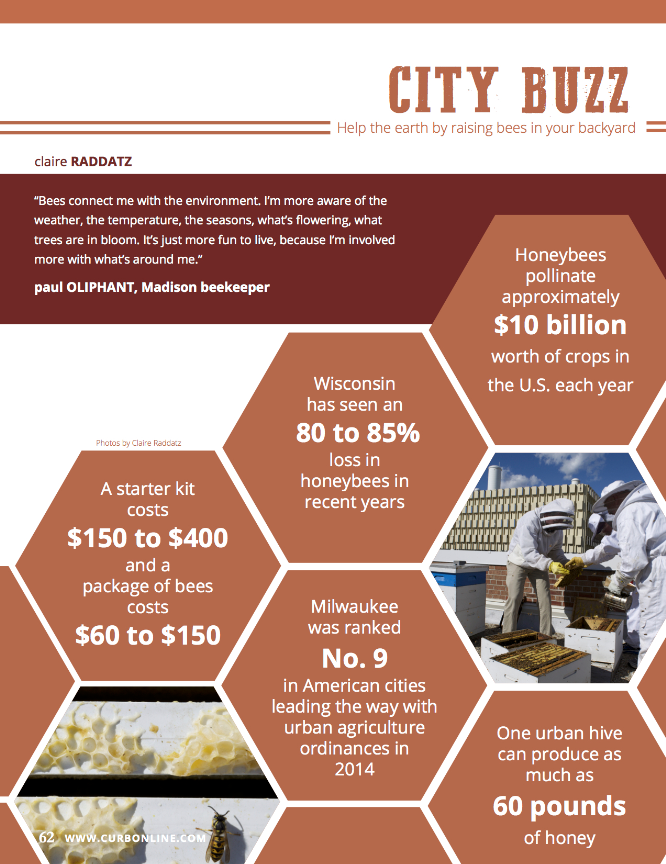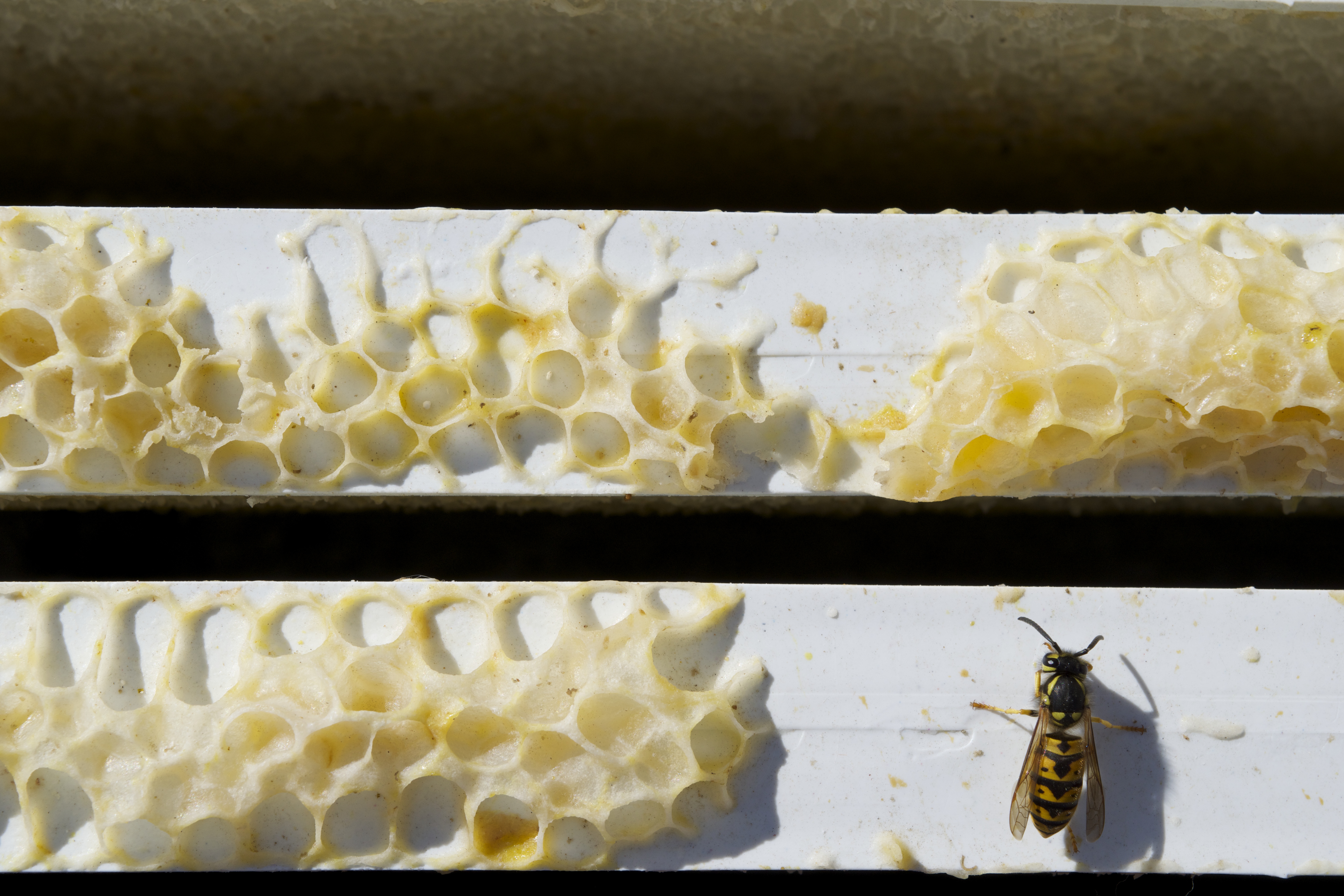There’s a new buzz in Paul Oliphant’s neighborhood. It’s not a fresh, juicy piece of scandalous gossip shared while walking the dog or mowing the lawn. It’s the thousands of new neighbors that just moved in.
They all live in Oliphant’s backyard, and he only checks on them at most every 10 days. No, they are not his closest friends and family, but hives of honeybees he keeps in his backyard in Madison. He finds that the benefits are substantial, both to him and his surroundings.
“Bees connect me with the environment,” Oliphant says. “Because of bees, I’m more aware of the weather, more aware of the temperature, more aware of the seasons, what’s flowering, what trees are in bloom. It’s just more fun to live, because I’m involved more with what’s around me.”
Despite the alarming decline of honeybees in our nation, Wisconsinites are pushing bee sustainability forward, especially in urban areas. Although there are challenges to raising bees within a city, beekeepers say anyone can keep bees with the right equipment and training, and it is rewarding both on a personal and macroscopic level.
Our country has faced a massive and rapid decline of honeybees in the last decade. Dave Hogg, professor of entomology at UW-Madison, says that a new class of insecticides called neonicotinoids, which cause short-term memory loss in honeybees, may be a contributing factor to colony collapse. This could also be due to the stress of being trucked all over the country to pollinate large, concentrated crops, such as almonds in California.
Having bees as pollinators in Wisconsin is essential for both the economy and the foods that we enjoy every day. Apples, cherries, raspberries, squash, cucumbers, carrots, radishes and a lot of the lettuces we grow need honeybees to grow properly. If the honeybees continue to decline, Wisconsinites may have to make some lifestyle sacrifices.

Beekeepers at UW-Madison work on their hives on top of Russell Laboratories. Photo by Claire Raddatz.
“I’m sure there would be an impact here, it’s kind of hard to put a dollar value on it,” Hogg says. “It certainly would create a situation that we would have to somehow adjust to, and we probably wouldn’t be as well off in the end as we are now.”
If you’re not thrilled by the idea of having thousands of flying insects housed in your backyard, there are other alternatives. Hogg says there are many ways to help bees with the everyday choices that you make, such as keeping bee-friendly and perennial gardens and being careful about the pesticide use around your home and on your lawn. Also, buying local produce means supporting local farmers and local pollinators.
“If you can keep bees, that’s great,” Hogg says. “The more hobby beekeepers, the better.”
Drowning in a suit of white and peering through a mesh opening, I trudged up the stairs toward the roof feeling like I was about to set foot on the moon. The door opened with a whoosh, and the crisp, fall wind aggressively greeted us. Roofs of familiar UW-Madison campus buildings spread out below us, as the stark blue lakes added a picture-perfect backdrop to the Russell Laboratory rooftop hives. The bright afternoon sun shone brightly onto the first hive as Hogg opened it up to deliver mite treatment, sending small buzzing creatures aflutter.
They swarmed and swirled, taking turns landing on my arms and crawling up my legs. One professor blew smoke over the hives to calm the bees, leaving the air thick with the comforting smell of burning wood, while another added treatment. It was tranquil, knowing with my protective suit I could be at peace with the bees and feel that I am a part of their flourishing and intricately complex environment.
The amount of thick, golden honey dripping from the combs excited the professors, yet they worked with a hurried urgency and precision to not overly disturb the bees. The enthusiasm was palpable, and I instantly felt the appeal of learning about and keeping bees.
Urban beekeeping ordinances and the availability of licenses vary by city. In a small city like Madison, there is an ordinance that works with local beekeepers to encourage beekeeping rather than restricting it. Before starting, check out the city-specific ordinances and laws.
Know that you don’t have to do all the work yourself. Learning to take care of them can be a process. Oliphant, who has been keeping bees since the mid-’90s, recommends starting with a mentor who keeps bees who can show you the ropes.
“Go ahead and take a new beekeeping class. Buy new equipment, don’t buy used equipment,” Oliphant says. “As a new beekeeper, used equipment can come with diseases and other problems that you might not know or understand, that could decimate your hive and you don’t know why. With new equipment you’re starting clean and fresh. Also, start with two hives, not one.”
Beehives each have their own personality, so according to Oliphant, starting with two hives helps you learn what is normal activity and livestock and what is not. You can buy packages of bees by either contacting a local beekeeper or bee distributor or having them mailed to your house. Packages usually each include a few thousand bees and a queen bee.
Learning personality traits of the hives isn’t the only concern. One of the biggest concerns for urban beekeeping is the difficulty of keeping the bees contained along with some neighbors’ fears and misconceptions of them.
“Bees are very interesting livestock to keep because you can’t just put up a fence and say, ‘Okay you’re going stay in this little backyard,’” Oliphant says. “They roam about, and they’re very promiscuous.”
While bees may roam, they always come back. Each hive as its own smell, and bees are good at remembering the exact location of their hive. That’s why pesticide use that results in memory loss is one of the top theories for the spike in colony collapse disorder.
Usually, bees will not swarm or become aggressive. They occasionally become aggravated when you decide to work with the hive, which you generally only need to do every 10 days to two weeks in the peak season of summer.
“I like to [work with my bees] in the evenings in my urban environments because then the bees will all calm down when it starts to get dark, but if I do it too late, they’re very annoyed at me and become more aggressive,” Oliphant says. “So I have to fit it in the right time. If I do it earlier in the morning, then I’m concerned that they’re going to be upset the whole day, rather than letting them calm down overnight.”
Maybe you are interested in keeping bees without having to deal with installation and managing? There’s a business for that.
In Madison, Nathan Clarke began a community-funded company called Mad Urban Bees, a project that places hives into people’s yards for a small cost to cover equipment and maintenance. The hosts get all of the benefits of pollination in their yard and a share of the honey.
“It’s a way for them to feel that they’re doing something for the bees, or for their neighborhood or for their garden, or just doing something different and fun without having to do any of the heavy lifting,” Clarke says.
Clarke’s passion for beekeeping stemmed from his interest in urban homesteading and his love for honey. He currently extracts honey from almost all of his hives throughout the season and sells the honey in a community supported agriculture coalition.
“What I do is I extract honey throughout the year, so as the flowers change, so does the honey. So I’m getting all of these really intense flavors,” Clarke says. Different flavors like cinnamon, mint, apple, caramel, butterscotch and nutmeg come out throughout the peak season depending on what flowers are in bloom. In commercial large batches of honey, “a lot of those really interesting peaks of stuff get rounded out, so I sell the small batch honey specifically for that reason,” Clarke says.
Although Clarke believes that individually keeping bees may not have a huge effect on the national decline, he does believe that urban beekeeping helps spark new ideas and initiatives for building a more sustainable future.
“It helps mentality. When you know your neighbor has bees and you get a jar of honey from them for the winter—and yes—bribery is a wonderful thing, but then they understand where that food, is coming from, and so they get a little bit more invested,” Clarke says. “I think the main part about local food especially in the urban setting, is that we have the ability to vote with our wallet. We have the ability to decide where we buy food from.”
However, keeping a hive or two is not going to fix the deep systemic problems in the agriculture industry, according to UW-Madison community and environmental sociology professor Daniel Kleinman and postdoctoral research associate Sai Suryanarayanan. Through their recent research project on the socioeconomics of bee decline, they believe that the bees would suffer regardless due to our nation’s current model of agriculture.
Suryanarayanan says that our current agricultural model focuses on large, monoculture farms, which are especially focused on corn and soy in the Midwest. Bees need a diversity of crops and plants. Since the wild bees in a local area are not sufficient anymore for crop pollination, farmers will hire beekeepers to bring truckloads of bees across the country to help.
“If you imagine some of these large monoculture settings, there are millions of beehives all sitting in different configurations in various places. It’s a great breeding ground for diseases,” Suryanarayanan says.
With all of the bees intermingling in a dense area, consuming a relatively unhealthy diet, and out of their natural habitats, large numbers of bees get sick and colonies collapse in large numbers.
However, they agree that urban beekeeping is usually not harmful, and also helps promote ideas for sustainable urban agriculture. As long as urban beekeepers educate themselves on the issues and begin to think about ways to implement sustainability in agriculture, this system could begin to heal the problem.
“If we had a more diverse agriculture, we would use less chemicals. If we used less chemicals, they might hurt the bees less,” Kleinman says. “If we had diverse, small-scale agriculture, we might need to ship honeybees less so they wouldn’t get so stressed from being on trucks.”
Urban sustainability initiatives have been popping up all over the state, as issues with large-scale farming become more transparent in the nation. Milwaukee was recently ranked number nine on Seedstock.com’s list of top 10 American cities leading the way with urban agriculture ordinances.
In a post-industrial city, the amount of land from foreclosed homes and vacant lots offers a lot of potential to start fresh with urban agriculture. HOME GR/OWN, a government-led environmental sustainability program initiative launched by Milwaukee Mayor Tom Barrett, “empowers residents to transform neighborhoods by repurposing foreclosed properties into community assets that spark new economic opportunities around local, healthy food production and distribution,” according to its website.
With this new initiative, urban beekeepers could make a huge difference in helping enhance these urban ecosystems. The biggest problem with urban areas is that it’s hard for the pollinators to find natural homes, so individuals hosting hives can help this vision flourish.
“I think urban beekeepers are one piece of the puzzle for future sustainability,” Suryanarayanan says, “but not by themselves.”
Whether your motivation is pollination for your garden, local food movements, honey, or just to try something new, many consider the biggest rewards of beekeeping is the opportunity to learn new things and think more about the environment around you.
“Bees are so interesting. I’m fascinated. I’ve been keeping bees since the mid-’90s, and I continue to learn new things every year,” Oliphant says. “My philosophy is to learn as much as I can from the bees — listening to the bees so to speak. I need my own bees to listen to.”


